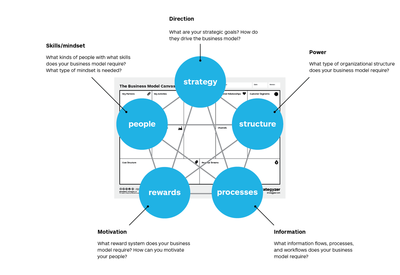The Star Model
Jay Galbraith defines the Star Model™ framework for organization design as "the foundation on which a company bases its design choices". The framework consists of a series of design policies that are controllable by management and can influence employee behavior. The policies are the tools with which management must become skilled in order to shape the decisions and behaviors of their organizations effectively.[1]
Components of The Star Model
What Comprises The Star Model[2]
The Star Model consists of five areas that should be connected and aligned to successfully shape the decisions and behaviors of your organization: Strategy, Structure, Processes, Rewards, and People. The business model is placed in the middle of the star as a "center of gravity" holding the five areas together. Decisions about the business model impact implementation across these five areas.

source: Strategyzer
- Strategy: An organization's strategy is defined by its vision, mission, and values as well as its goals and objectives. Strategy sets out the direction of the organization.
- Structure: An organization's structure determines the type and number of job specialties needed as well as decides the number of departments and people in each department. It dictates the placement and movement of power and authority, and is the basis for forming departments.
- Processes: Organizational processes are defined by the flow of information and decisions. Those flows can happen vertically or horizontally. Vertical processes deal with allocating funds and talent via budgeting and planning.
- Rewards: Reward systems align the goals of employees with the goals of the organization. The system must use appropriate incentives to motivate workers to do the right things to fulfill the strategic direction of the organization.
- People: An organization's human resource policies govern recruitment, promotion, rotation, training and development. Those policies are designed to produce the talent and build the capabilities necessary to execute the strategic direction of the organization. They must be in harmony with the other design areas.
References
- ↑ Definition: What is Jay Galbraith's Star Model for Organization Design? Jay Galbraith
- ↑ What is the Star Model Comprised Of? Strategyzer
